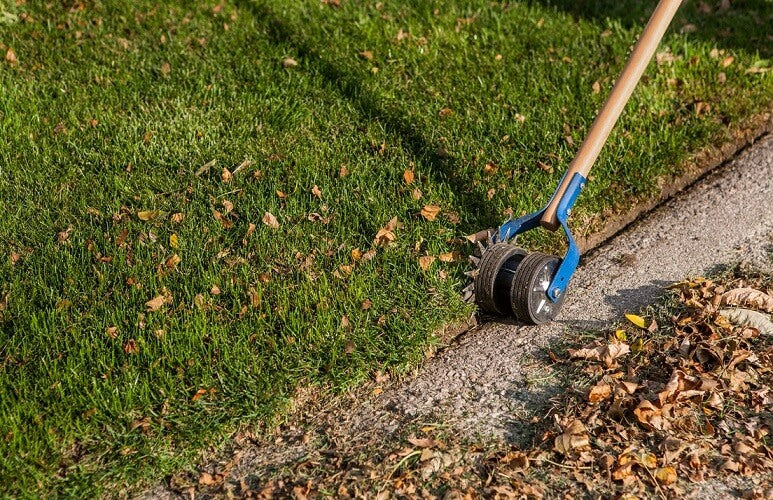Simply press a button, and the lawn mower begins to move at a steady pace along the S line, leaving fine clippings on the lawn. Sounds nice, right?
Robotic lawn mowers have gradually become a thing, especially in recent years. Still, many people are on the fence when it comes to buying a robotic lawn mower.
How does a robotic mower work? Does it really do what you want? Robotic lawn mowers are much more advanced, but they aren’t complicated to understand. This article provides an introduction to everything you need to know about how a robotic lawn mower works and beyond.
What Is a Robotic Lawn Mower?
A robotic lawn mower is a robot that can autonomously mow the lawn. It uses advanced positioning and navigation technologies (such as RTK and GPS) to define lawn areas and plan paths. It typically comes with an AI vision system to identify and avoid obstacles, such as pets and toys, enabling efficient, safe, and intelligent mowing without human intervention. Compared to traditional lawn mowers, robotic lawn mowers provide a more convenient and efficient lawn mowing experience.

Basic Components of a Robotic Lawn Mower
To learn more about a robotic lawn mower, here’s a list of its basic components:
Control / Navigation System: It’s the brain of a robotic lawn mower, consisting of various kinds of microprocessors and sensors, including ultrasonic sensors, infrared sensors, GPS modules, etc., making the machine autonomous and competent to avoid obstacles, create a virtual map of the lawn, and implement a customized mowing schedule.
Cutting Mechanism: Robotic lawn mowers usually feature blades made of high-strength materials that can cut grass unevenly at a set height, creating clippings as a natural fertilizer. And the cutting deck lets you adjust the cutting height based on your lawn conditions and your preference.
Power Supply: Robotic lawn mowers are usually powered by rechargeable lithium-ion batteries and equipped with wheels and drive motors to move forward, backward, and rotate. Some models will automatically return to the charging station when the battery is low, ensuring they’re always ready for the next mowing cycle.
Wheels & Traction System: The most substantial component in a robotic lawn mower is usually its wheels, which are made of tough materials with grooves, enabling them to move over different kinds of terrains. The motor inside, together with a traction system, drives the wheels.
How Do Robotic Lawn Mowers Work?
Probably, you already have a rough idea about how a robotic lawn mower works after learning its basic components. Listed below is a summary of how it works.
Setting Up
Set up the boundary for the robotic mower to mow, so it won’t go into unwanted areas. You may install a perimeter wire or use GPS to create an invisible “fence” around the lawn through the App, depending on the specific model you’re using.
Next, you can set up specific mowing schedules. This gives the mower the autonomy to operate during set times, maximizing efficiency and minimizing disruption.
Mowing Process
Once set up, you can leave the mowing to the machine. The robotic mower will map the lawn and plan optimal paths to ensure complete and even coverage without random bouncing. Usually, they will move in a systematic, straight-line pattern with the help of GPS navigation.
Returning to the Charging Station
When the cutting cycle is complete or when the battery is low, the robotic lawn mower will automatically return to its storage and charging station, if there is one. A lawn mower garage is recommended since it can protect the mower from the weather and keep it in good condition for the long term.

Maintenance
From time to time, clean the mower deck to improve airflow, prevent rust, and maintain cutting efficiency. Also, check whether there’s damage. Over time, the blade may get dull, or some nuts may get loose. Fix the problem once you spot it.
Types of Robotic Lawn Mowers
Robotic lawn mowers can be categorized into two types based on how they set up the boundary: wire-guided and wire-free. Both can operate autonomously and handle lawns of different sizes.
Wire-Guided Lawn Mowers
As the name implies, a wire-guided lawn mower uses a perimeter wire, buried or laid above ground, to define the mowing area. This wire emits a signal that the mower detects, ensuring it stays within the designated boundaries. While this installation can be labor-intensive, it allows the mower to navigate precisely within the designated space. Moreover, you can easily change the lawn boundaries whenever needed.
Wire-Free Lawn Mowers
On the other hand, wire-free robotic lawn mowers employ AI and intelligent navigation systems to automatically map the yard. Most wire-free models feature RTK, GPS or vision-related AI algorithms to detect boundaries and avoid obstacles, creating an optimal path for efficient, care-free lawn care.

Benefits of Robotic Lawn Mowers
Many people prefer robotic lawn mowers because they outperform traditional mowers in so many respects. Here’s a summary of some important benefits that robotic lawn mowers provide.
Time-Saving
The biggest advantage of using a robotic lawn mower could be that it frees you from manual operation. You can sit in your room and enjoy your reading while the mower is doing its job in the garden, just as expected.
Efficient Cutting
Through an optimal path guided by advanced technologies, robotic lawn mowers can provide a finer cutting with greater coverage, improving the overall lawn condition in the long run. And the mulching returns nutrients to the soil to ensure a healthy lawn.
Quiet Operation
Battery-powered robotic mowers are generally much quieter, operating with noise around 70dB or even lower, given that electric motors produce less noise than internal combustion engines found in gas-powered mowers, which can generate noise over 90dB. Some robotic lawn mowers are so quiet during operation that you can even run them at night without worrying about disturbing the neighborhood.

Less Maintenance Effort
As mentioned earlier, robotic lawn mowers are self-charging, so they require less upkeep than gas mowers. Not to mention, most models are proof against water, dust, and sunlight, ensuring their longevity.
Environmentally Friendly
Obviously, robotic lawn mowers produce zero emissions because they are battery-powered, making them a sustainable option for lawn carers. On the other hand, the clippings they produce will be left on the lawn to act as a natural fertilizer. Your garden matters, so does clean air and your carbon footprint.
It goes without saying that buying a robotic lawn mower will be a good investment since it offers so many benefits. If you’re considering buying one, take a look at the Navimow i105 Robotic Lawn Mower.

With an advanced GPS and camera navigation system, the mower can offer centimeter-level precision without boundary wires as well as identify and navigate around numerous obstacles. It features a climbing capability up to 30% (17°), so it can adapt to evolving slopes.
Also, the mower is IP66 waterproof and capable of detecting the weather conditions, so when it’s raining, it will pause operation and return to its charging dock. And of course, you can control it through the dedicated App on your phone while it’s quietly cutting at 58dB(A) at the lawn.
How to Choose the Right Robotic Lawn Mower for Your Needs?
Robotic lawn mowers offer so many benefits that they’re preferred by so many modern homeowners. However, before making a purchase, there are several important factors to consider.
Lawn Size
The size of your lawn is one of the first things to consider. Measure your lawn and check the specifications of the mower to ensure it can handle your yard. Robotic lawn mowers can cut lawns from small to large sizes. The bigger size it can handle, the more expensive it is.
Obstacles
Consider the layout. If the terrain is complicated with obstacles like trees or flower beds, choose a model that can navigate complex environments. If your outdoor space is full of pebbles and sand, pick a mower with big and grippy wheels that move around over uneven surfaces.
Maintenance
Check carefully the maintenance requirements of the mower. An easy-to-maintain mower can save you tons of trouble and cost in the long-term perspective. So don’t forget to check whether the manufacturer provides blade replacement, general upkeep and a reliable warranty, so you won’t freak out even when something goes wrong and you are not that tech savvy.
Smart Features
Smart features such as scheduling and voice control via smart home systems like Alexa would be a bonus, as they allow you to remotely start, stop, or monitor the mower when you’re in other parts of the world. If you fancy a specific smart feature, pick a model that is smart enough to do what you want.
Budget
Last but not least, robotic lawn mowers come with different prices, which are mainly decided by the size it can handle, how intelligent it is, and how easy it is to operate and maintain. While the good ones usually cost more, it’s a good investment if you consider the maintenance fee that you can save. And a premium lawn mower with easy maintenance usually lasts for at least five years, which means you don’t need to keep on buying new ones.
FAQ
How do robotic mowers know where to cut?
Robotic mowers use boundary wires or advanced sensors to navigate obstacles and understand the terrain, so as to determine where to cut grass in your yard.
Where does the grass go in a robotic lawn mower?
A robotic lawn mower will mulch, cutting the grass into tiny pieces that fall to the soil and decompose naturally.
Why are robotic lawn mowers the sustainable choice?
Robotic lawn mowers are powered by rechargeable batteries instead of gas, so they produce zero emissions, making them an environmentally-friendly choice for lawn care.
Conclusion
Now, hope you are clear about how a robotic lawn mower work. To summarize, robotic lawn mowers are a blend of navigation technology, cutting mechanisms, safety features and smart connectivity. They simplify lawn care by providing an efficient and user-friendly solution for homeowners. Time to revolutionize your gardening with a robotic lawn mower!






Share: